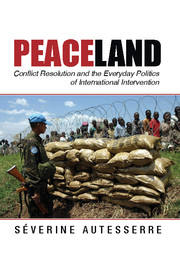Book contents
- Frontmatter
- Contents
- Figure and Tables
- Acknowledgments
- Introduction
- 1 Studying the Everyday
- Part I Constructing Knowledge of the Host Country
- Part II Constructing and Maintaining Boundaries
- 5 The Interveners’ Circle
- 6 A Structure of Inequality
- 7 Daily Work Routines
- Conclusion Transforming Peaceland
- Appendix An Ethnographic Approach
- Bibliography
- Index
- References
5 - The Interveners’ Circle
Published online by Cambridge University Press: 05 July 2014
- Frontmatter
- Contents
- Figure and Tables
- Acknowledgments
- Introduction
- 1 Studying the Everyday
- Part I Constructing Knowledge of the Host Country
- Part II Constructing and Maintaining Boundaries
- 5 The Interveners’ Circle
- 6 A Structure of Inequality
- 7 Daily Work Routines
- Conclusion Transforming Peaceland
- Appendix An Ethnographic Approach
- Bibliography
- Index
- References
Summary
During my formal conversations and in informal settings, certain phrases recurred that revealed how the inhabitants of Peaceland often perceived the interveners’ identity. Foreign peacebuilders would start sentences with “we, the international community” or “we, the expatriates.” They would refer to “the international system” or “the international machinery” and would mention their feeling of being part of a “huge family” that is here to help the country of intervention. The phrases that noninterveners – including local elites, business expatriates, or missionaries – used to refer to interveners were often less kind, such as “the humanoids” or “les criseurs” (those who come when there is a crisis, behave as though everything is an emergency, and act with reckless impatience to resolve a problem). Reflecting on her experiences in various conflict zones, including Juba (South Sudan) and Aceh (Indonesia), a peacebuilder working for a non-governmental organization (NGO) explained:
It is personal and professional. When we talk about multiculturalism, there is a shared nod around the table: We are here as a bloc, as the international community; we operate as one. [. . . .] You just assume it. It is a given.
International interveners and local citizens have even created blogs that discuss – and mock – this community, such as Stuff Expat Aid Workers Like and Stuff Malai Like (“Malai” referring to expatriates deployed in Timor-Leste).
This chapter demonstrates that interveners on the ground form a specific group – one that might be called a community of practice. Four elements enable a group identity to develop in spite of internal differences and tensions: a shared official goal (to help the host country and its people), a common experience of life in conflict zones, dense professional and social interactions, and the presence of an “Other” (host populations) against whom interveners can construct their identity. This chapter analyzes the group’s shared characteristics, its internal dividing lines, its relations with nonmembers, and the exceptions to its dominant trends. Throughout, I study not only the intended effects of the social dynamics I describe (to enable interveners and their organizations to function in conflict zones and to help the host country build peace), but also their unintended effects, particularly the construction of boundaries between international peacebuilders and local populations.
- Type
- Chapter
- Information
- PeacelandConflict Resolution and the Everyday Politics of International Intervention, pp. 161 - 193Publisher: Cambridge University PressPrint publication year: 2014



